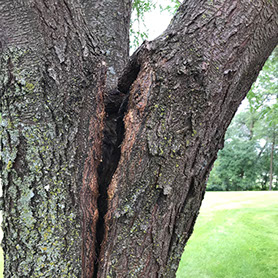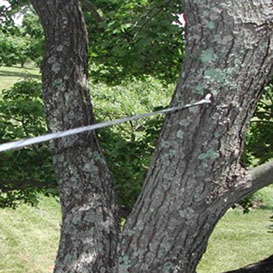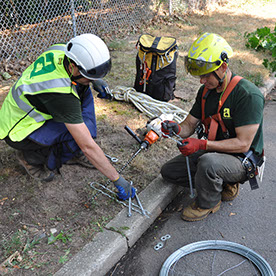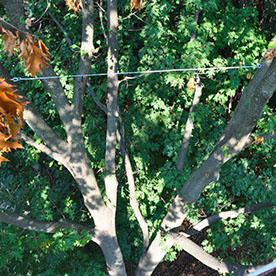
Winter 2020
The science of preserving nature since 1964
Co-Dominant Stems and Included Bark
During the recent storm, Iaisis, and during most extreme weather events, probably the most common defect, and reason for tree failure we've found is due to Included Bark at co-dominant branch connections. With winter fast approaching, it is prudent to think about the trees on your property. It may be a good idea to have an Almstead arborist perform an inspection of your trees surface roots, trunk and canopy.
Included Bark is a type of branch defect that develops when two or more stems (co-dominant stems) grow closely together in a V-shape. As both the stems increase in circumference, the bark that is between them will start to work as a wedge between the growing branches. When this occurs, the stems lack the reinforcing ridge required for the branches to be supported properly. If not inspected, managed and repaired, these stems can break or tear causing severe cambium damage and making them prone to failure. It increases the susceptibility of the tree to storms and heavy winds.
Tree failure from Included Bark can be managed by bracing and cabling the tree (see images). Braces (bolts) installed through the branches with the same common crotch take the stress off those branches and help prevent them from breaking or tearing off. Cables installed at the top of the tree reduce the amount of movement of the branches due to wind and prevent undue stress on the co-dominant stems.
To check for Included Bark, look for two or more separate large vertical tree branches that are growing close together with a V-shape at the crotch. See if there is adequate space between them for their continued growth. An arborist should inspect the tree to see if cabling and bracing is possible. Trees with extensive decay may need to be removed promptly to avoid property damage or injury to people.
When trees are young, many of these defects can be corrected through proper structural pruning. Select reduction cuts to subordinate and slow down the growth of one of the branches can be helpful as is removal of one of the branches, if not too large of a cut. It may require a few pruning cycles to make the improvement and correction required.


Included Bark can be identified by the sharp "V" shape in the junction of branches. There could also be a slight bulging on the side because of being sandwiched between two stems as the tree grows. Included bark becomes more of a danger as the tree matures. High winds and heavy snow can put significant stress on tree branch unions, ultimately causing them to split and break at the junction.





When we have a mature tree with a condition that may have existed for some time, our remedies are to perform branch end thinning reduction cuts to reduce chances of failure and to use proper size support cables, and possibly bracing (see images above).

LOCATIONS:
Lower Westchester County, NY and New York City
58 Beechwood Ave, New Rochelle, NY 10801
914-576-0193
Upper Westchester (North of I-287)
15 Broadway, Hawthorne, NY 10532
914-741-1510
Fairfield County, Connecticut
547 Hope Street, Stamford CT 06907
203-348-4111
Bergen & Passaic Counties, NJ
504 High Mountain Road, North Haledon, NJ 07508
973-636-6711
Contact us for a Free Consultation